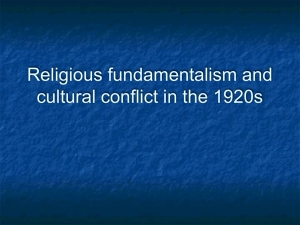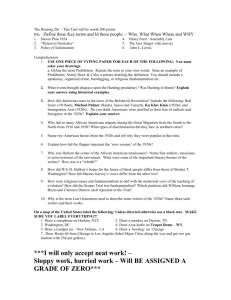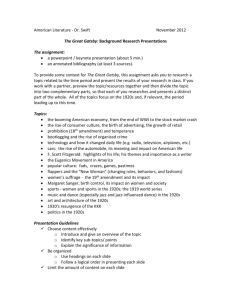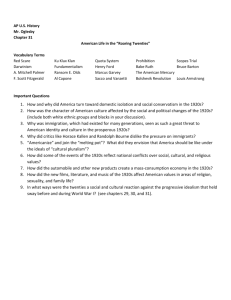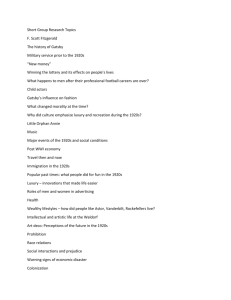AH 2 1920s and 1930s Riches to Rags
advertisement
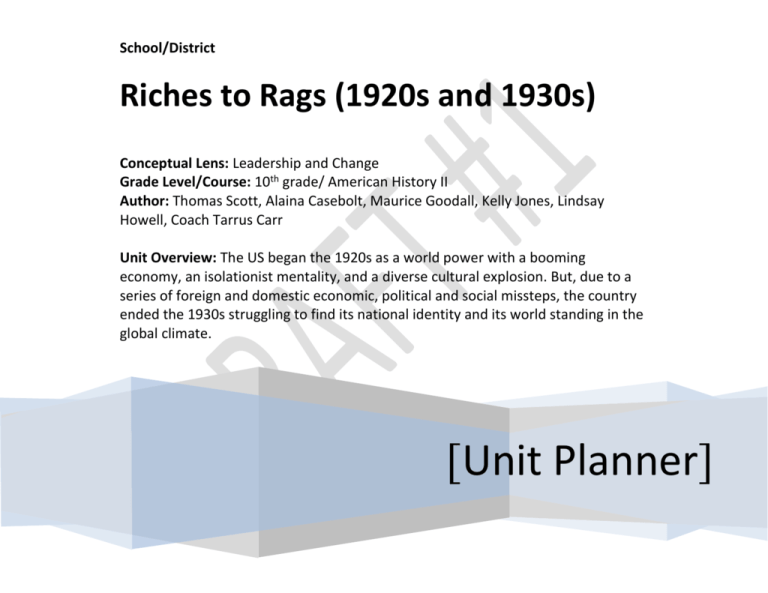
School/District Riches to Rags (1920s and 1930s) Conceptual Lens: Leadership and Change Grade Level/Course: 10th grade/ American History II Author: Thomas Scott, Alaina Casebolt, Maurice Goodall, Kelly Jones, Lindsay Howell, Coach Tarrus Carr Unit Overview: The US began the 1920s as a world power with a booming economy, an isolationist mentality, and a diverse cultural explosion. But, due to a series of foreign and domestic economic, political and social missteps, the country ended the 1930s struggling to find its national identity and its world standing in the global climate. [Unit Planner] History - Great Depression (change) American Dream (patterns) FDR (Leadership) Lifestyle changes (Identity) Republican- Democrat shift (rule of law) Fundamentalism (values and beliefs) Consumerism (need/ want) Civics and Government - Presidents of the 1920s and 1930 (Leadership) Prohibition (18th Amendment, Volstead Act) (Rule of law) New Deal (Domestic Policy) Return to Normalcy (Leadership) Isolationism (Foreign Policy) Kellogg Briand Pact (Foreign Policy) Geography and Environmental Literacy CONCEPT/CONTENT WEB - Riches to Rags (1920s1930s) Economics and Personal Financial Literacy - - - Great Migration (settlement patterns) Dust Bowl/ overproduction (Human Environment) Okies (settlement patterns) TVA, CCC (Human Environment) Rural to Urban (settlement patterns) Great Depression (needs/ wants) Materialism, speculation (needs and wants) Hoovervilles (resources) Black Tuesday/ bank runs (market economy) Laissez- Faire, volunteerism, pump priming, trickle- down economics (economics systems) Dawes Repayment Plan (reform) New Deal (reform) Hawley Smoot Tariff (market economy) Culture - - Red Scare (values and beliefs) Harlem Renaissance (identity) AIM (identity) Flappers, “New Woman” (identity) Immigration (identity/ diffusion) Hoovervilles (quality of life) Literature: Lost Generation, Imagism, Modernism (Identity) Bonus Army (quality of life) Fundamentalism (identity) “New Celebrity” (identity) Prohibition Culture (values/ beliefs) New Deal/ WPA (quality of life) KKK (values) Other Subjects Page 2 of 8 Essential Understandings (Generalizations) and Guiding Questions: Generalizations Guiding Questions History Changes in cultural patterns and the availability of resources shape the needs and wants of a society. History Geography & Environmental Literacy Settlement patterns and movement are often influenced by human interaction with the environment. Geography & Environmental Literacy Civics & Government Changes in leadership may cause fundamental shifts in policy making- both foreign and domestic. Civics & Government Page 3 of 8 1. How did the consumerist culture in the 1920s influence the scarcity of resources in the 1930s (Great Depression)? (F) 2. Is the American Dream still accessible? (PF) 3. How do changes in cultural patterns and the availability of resources shape the needs and wants of a society? (C) 1. In what ways can poor environmental practices and poor resource management cause settlement patterns to shift? (C) 2. How did environmental policies in the 1920s contribute to a depletion of resources? (F) 3. In what ways did the New Deal policies attempt to redress the negative impacts of 1920s land management policies? (F) 1. Why did America return to an isolationist policy following WWI? (F) 2. Why do crises allow leadership to move in more progressive directions? (C) 3. Does the rule of law limit or expand the power of government in the 20s and 30s? Economics & Personal Financial Literacy Economic crisis often forces leadership to follow new and innovative patterns. Economics & Personal Financial Literacy Culture Cultural identity and values are often shaped by technological innovations. Culture Other Subjects Critical Content and Skills Students Will Know… (factual content) 1. 1. How does leadership impact economic policy? (C) 2. Why does government response to economic conditions lead to innovative policies? (C) 3. What caused the economic policies of the 1920s to fail when faced with the unprecedented magnitude of the Great Depression? (F) 1. Why did consumerism flourish in the 1920s? (F) 2. How do new technologies lead to a national identity? (C) 3. Why do technological innovations cause generational divisions, creating tensions between those who wish to remain more traditional and those who want to “move with times”? Other Subjects Q = Quizzes T = Tests P = Prompts AC AC = Assessment Codes SA = Student Self-Assessment WS = Work Samples PT = Performance Tasks Students will be able to do… (key skills) 1. Page 4 of 8 O = Observations D = Dialogues AC 2. 2. 3. 3. 4. 4. 5. 5. 6. 6. Performance Tasks and Scoring Guides/Rubric Performance Task #1 including Scoring Guide/Rubric Page 5 of 8 Performance Task #2 including Scoring Guide/Rubric Suggested Learning Experiences CORRELATIONS → Enduring Understanding 1. 2. Page 6 of 8 Critical Content Key Skills 3. 4. 5. 6. 7. 8. 9. Unit Materials/Resources Teacher Notes Page 7 of 8 Page 8 of 8

